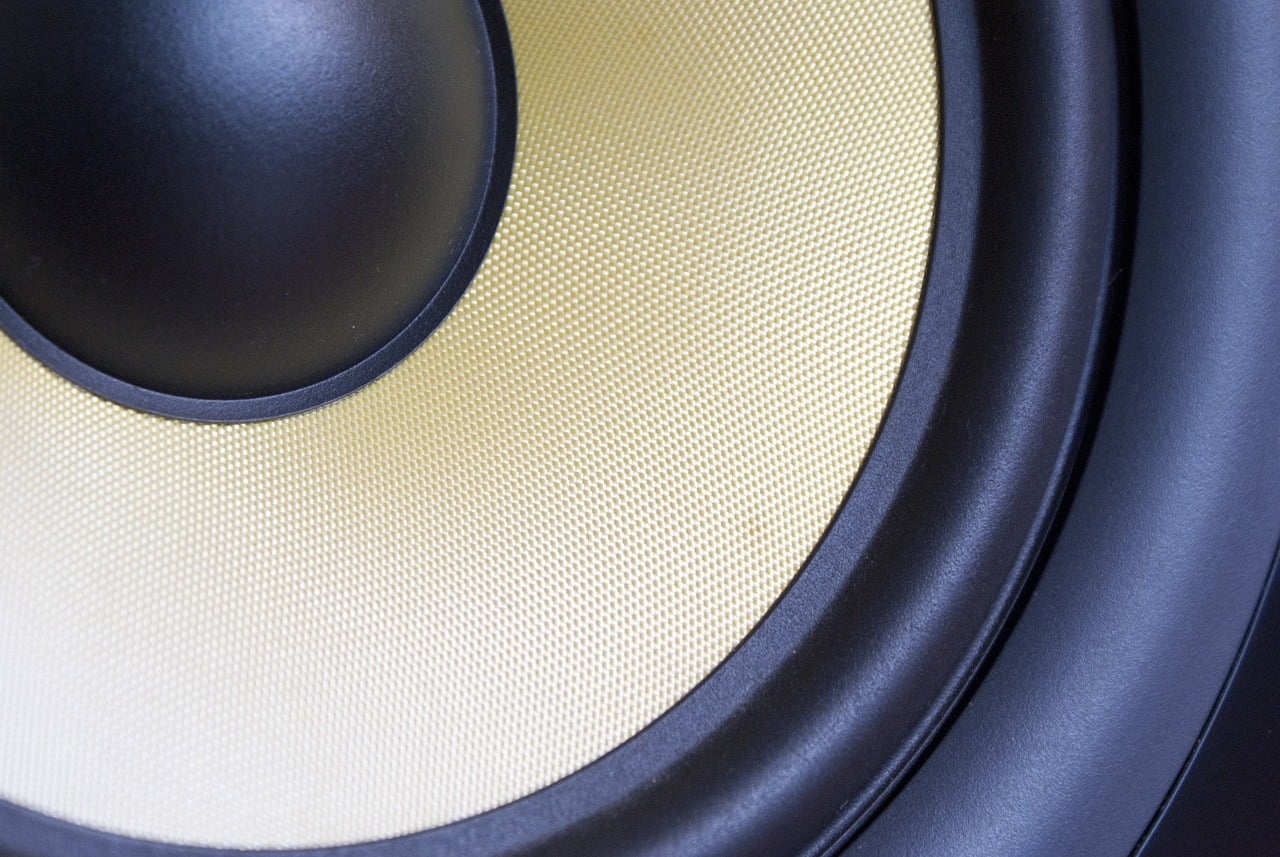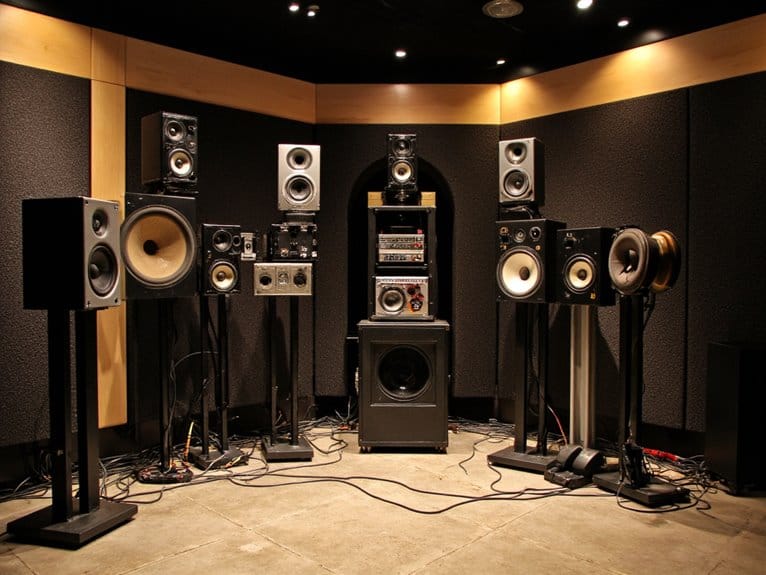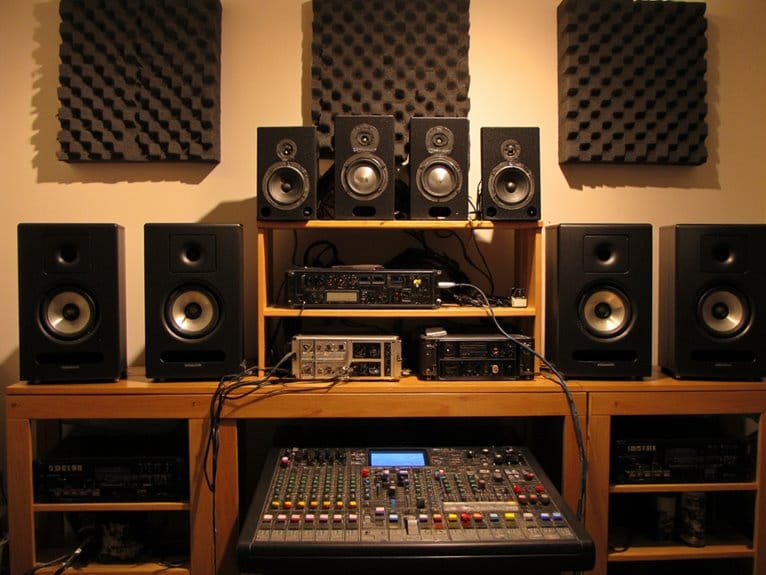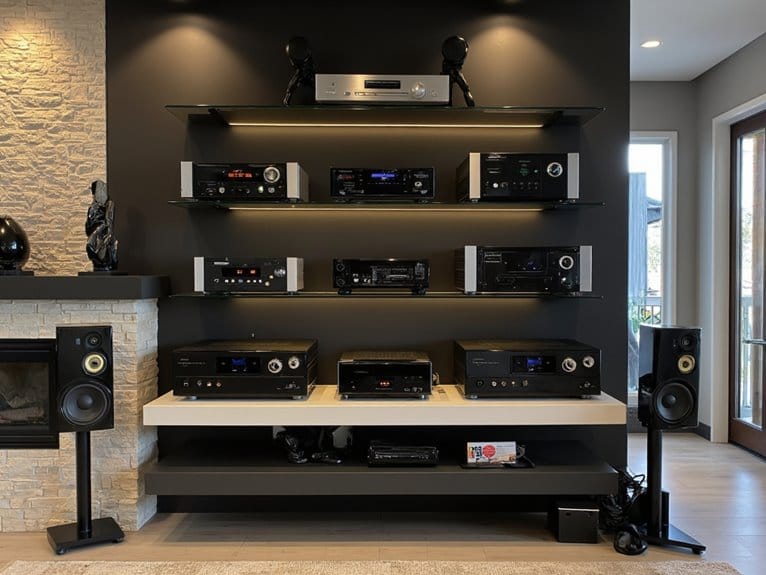Studio Monitor Placement: Best Practices for Optimal Sound Imaging
Proper studio monitor placement is crucial for achieving ideal sound imaging. Angles, distances, and room acoustics all play essential roles in enhancing stereo imaging and minimizing unwanted reflections. Placing tweeters at ear level is key for clarity and precision in sound delivery. Equilateral triangle setup and ear-level positioning help achieve balanced stereo imaging and minimize reflections. Ensuring appropriate monitor height and placement is essential for an immersive audio experience. Strategic placement of monitors helps maintain accuracy and precision in sound reproduction. By following these best practices, you can optimize your studio monitor setup for ideal sound imaging.
We are supported by our audience. When you purchase through links on our site, we may earn an affiliate commission, at no extra cost for you. Learn more.
Importance of Proper Monitor Placement
Why is proper monitor placement critical for achieving accurate sound imaging in a studio setting? The positioning of monitors plays a pivotal role in determining the quality and precision of the audio experience. Placing monitors at the correct angles and distances relative to the listening position is essential for ideal stereo imaging. By strategically positioning the speakers, one can minimize unwanted reflections and phase cancellations, resulting in a more balanced and accurate sound reproduction.
When considering speaker placement, it is important to take into account room acoustics. Rooms with poor acoustics can distort the sound coming from the monitors, affecting the overall listening experience. Proper monitor placement helps mitigate these negative effects, making sure that the audio signal remains true to its original form.
Moreover, positioning the tweeters at ear level is a critical aspect of monitor placement. This placement ensures that the direct sound from the speakers reaches the listener’s ears without any interference, enhancing the clarity and precision of the audio. Achieving this alignment not only improves the sound quality but also contributes to creating an immersive soundstage where the listener feels surrounded by the music or audio content.
Achieving Sound Imaging Precision
To guarantee precise sound imaging accuracy in a studio setting, meticulous attention to monitor placement is essential. When aiming for ideal sound imaging precision, the following steps must be taken into consideration:
- Equilateral Triangle Setup: Position the studio monitors and the listening position to form an equilateral triangle. This arrangement guarantees balanced stereo imaging and accurate sound representation.
- Ear Level Placement: Set the studio monitors at ear level height to minimize reflections. Direct sound delivery to the ears enhances imaging precision and reduces interference from surrounding surfaces.
- Avoiding Obstacles: Keep obstacles and reflective surfaces away from the monitors to maintain clarity in sound imaging. By preventing unwanted reflections, the accuracy of the audio representation is preserved.
- Preventing Acoustic Issues: Place the studio monitors strategically, away from walls and corners to avoid acoustical problems. This setup helps in reducing sound distortions and ensures that the stereo imaging remains accurate and precise.
Setting Up the Equilateral Triangle
Ensuring precise sound imaging accuracy in a studio setup necessitates implementing the equilateral triangle configuration for ideal stereo balance and soundstage fidelity. Placing the monitors and listener at the vertices of an equilateral triangle forms the basis of this setup. By aligning the monitors towards the listener, a focused sweet spot is created where the audio from the left and right channels converges optimally. This geometry minimizes phase issues and ensures that the listener experiences the mix as intended by the audio engineer.
The equilateral triangle setup is essential for achieving ideal sound imaging. It enhances the stereo imaging capabilities of the monitors, allowing for a more accurate representation of the audio signal’s spatial characteristics. When the listener sits at the apex of this triangle, the soundstage is well-defined, and the different elements of the mix are presented in their correct positions.
Moreover, this configuration fosters a cohesive listening experience by reducing unwanted interactions between the direct and reflected sound waves. As a result, the listener perceives a clearer and more detailed audio image, which is essential for critical monitoring tasks. Implementing the equilateral triangle setup is a fundamental step towards creating an accurate and immersive listening environment in the studio.
Optimal Height for Monitors
Positioning studio monitors at ear level is vital for direct sound delivery to my ears. Ensuring the tweeters are at the same height as my ears is essential for accurate sound direction. Placing monitors at the correct height reduces unwanted reflections and enhances stereo imaging.
Monitor Ear Level
Positioning studio monitors at the key height for ear-level listening is crucial for achieving precise sound reproduction and enhancing the stereo imaging experience. When setting up monitors at ear level, consider the following:
- Tweeter Alignment: Make sure the tweeters are at the same height as your ears for ideal high-frequency perception.
- Reduced Sonic Interference: Placing monitors at ear level minimizes sonic interference from surfaces near the speakers.
- Elimination of Phase Issues: Ear-level placement reduces unwanted reflections and phase issues, enhancing sound accuracy.
- Enhanced Stereo Imaging: Correct monitor elevation improves stereo imaging, providing a more immersive audio experience.
Desk Surface Height
When optimizing studio monitor placement for ideal sound imaging, consideration of the desk surface height is crucial to ensure accurate sound direction and alignment with the listener’s ears. The desk surface height should be set at a level where the monitors’ tweeters align precisely with the listener’s ears when seated, ensuring a direct sound experience. This correct positioning not only enhances the sweet spot, improving the audio clarity, but also contributes greatly to the overall studio monitor performance. By adjusting the desk surface height to match the ear level, reflections are minimized, stereo imaging is enhanced, and the listener can enjoy a more precise and immersive sound environment. Proper monitor positioning on the desk surface is essential for achieving top-notch sound quality and monitoring accuracy.
Avoid Reflections and Obstructions
To achieve ideal sound imaging and minimize reflections and obstructions, set studio monitors at a height typically ranging between 36-40 inches from the floor to the tweeter.
- Position monitors at ear level to guarantee direct sound delivery.
- Best height prevents sound distortion and reflections.
- Avoid placing monitors too high or too low to maintain clarity.
- Enhance sound imaging by reducing unwanted reflections with proper monitor height.
Minimizing Reflections for Clarity
One must approach reflections in a room to guarantee the best sound clarity, as they can greatly impact sonic interference and coloration. Reflections occur when sound waves bounce off hard surfaces, creating multiple paths that reach the listener’s ears at slightly different times. This phenomenon leads to comb filtering, where certain frequencies cancel out, degrading the audio quality and accuracy.
To minimize reflections and improve sound clarity, incorporating absorption materials is vital. These materials are designed to reduce the amount of sound that bounces off surfaces, diminishing unwanted reflections. Placing absorption panels strategically on walls or ceilings can help in absorbing excess sound energy and preventing it from interfering with the direct sound from studio monitors.
When setting up a studio monitor placement, it is important to identify areas where reflections are prominent. Using flat mirrors can aid in detecting these reflections by visualizing where sound waves are bouncing off surfaces. By pinpointing these areas, one can then apply absorption materials effectively to mitigate reflections and enhance sound quality.
Addressing Low-Frequency Issues
I’ll begin by emphasizing the significance of bass trap placement and the potential issues caused by speaker boundary interference. These factors play a vital role in addressing low-frequency problems by absorbing excess bass energy and minimizing unwanted reflections. Properly managing bass traps and speaker positioning can greatly enhance the accuracy and balance of low-end sound reproduction in a studio environment.
Bass Trap Placement
Strategically placing bass traps in room corners effectively combats low-frequency issues by absorbing sound waves and reducing bass build-up and standing waves. When considering bass trap placement, follow these guidelines for the best results:
- Corner Placement: Install bass traps in room corners to target low-frequency resonances efficiently.
- Symmetrical Positioning: Make sure bass traps are symmetrically placed for balanced absorption.
- Varied Depths: Use bass traps with various depths to capture a broader range of low frequencies.
- Coverage: Cover multiple corners of the room to address bass build-up comprehensively.
Speaker Boundary Interference
To address low-frequency issues related to Speaker Boundary Interference (SBIR), it is important to maintain a sufficient distance between speakers and walls to minimize bass build-up and guarantee ideal sound quality. SBIR in small rooms can lead to exaggerated low frequencies and muddiness in the sound, affecting the overall bass response. Placing speakers at least 43 inches away from the front wall helps reduce the impact of SBIR on the low end. Additionally, positioning rear-ported speakers away from walls can minimize low-frequency problems caused by SBIR effects. Using EQ settings can further aid in mitigating bass issues near side walls, ensuring a more balanced sound reproduction by addressing room modes effectively.
Genre-Specific Optimization Techniques
When optimizing sound imaging for different music genres, consider employing genre-specific techniques for studio monitor placement. To achieve the best results, it’s essential to tailor the monitor setup to the characteristics of the music genre being produced. Here are some genre-specific optimization techniques to enhance sound imaging:
- Electronic Music: Symmetrical monitor placement is ideal for electronic music as it helps in achieving a balanced stereo imaging, vital for creating immersive electronic soundscapes.
- Classical Music: For classical genres, wider spacing between monitors is recommended to accurately reproduce the intricate details and dynamics inherent in classical compositions.
- Hip-Hop and Rock Music: Closer monitor placement is beneficial for hip-hop and rock genres as it can enhance the reproduction of low-end frequencies, providing that impactful and deep bass characteristic of these styles.
- Experimental Approach: Experimenting with monitor positioning based on genre characteristics can lead to optimized sound imaging. Adjusting the monitor height according to the genre-specific needs can further refine the listening experience and overall sound quality.





